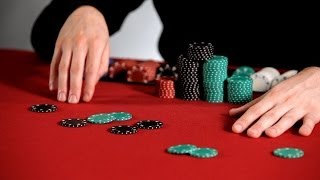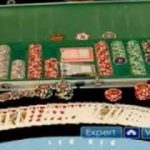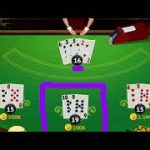Learn Texas Holdem Video Source & Info:
Like these Gambling Lessons !!! Check out the official app http://apple.co/1HCxrup
Watch more How to Play Poker videos: http://www.howcast.com/videos/515011-How-Much-to-Raise-Poker-Tutorials
Hey, I’m Nicky Numbers, Professional Poker Player, and I’m going to help you learn how to size your raises.
The first thing you need to know about raising is when you can raise and when you can’t because it’s so common for people to confuse the terms “bet” and “raise”.
Pre-flop, there are blinds. Say in this example, the blinds are 25/50. Well, the minimum raise that you can make in pre-flop is twice the size of the big blind, also referred to as a 2X raise, where the X is a shorthand for the multiplication symbol. So 2X the big blind means two times the big blind. 2-1/2X the big blind is two and a half times the big blind.
So here we have blinds of $25 and $50. If I were to raise to 3 times the big blind, I would make it 3 times $50 or $150. A standard raise pre-flop is anywhere from two big blinds all the way up to ten big blinds, depending on the game.
However, it’s very common to see raises of two big blinds, two and a half big blinds, even two and a quarter big blinds or three big blinds or four big blinds. Those are the amounts you’re going to see the overwhelming majority of the time.
The key is that when you’re raising pre-flop, that you stick with an amount and you stay with it.
So if I’m going to raise to $125 pre-flop, which is two and a half times the big blind, then I’m going to raise two and a half times the big blind consistently. That way I don’t give my opponents any information.
If I sometimes make it three times the big blind at $150, and then other times I only minimum raise and make it $100 and still make it other times I raise 4X and make it $200, well then I have differing raise sizes which means I’m going to fall into a pattern over time of raising certain amounts with certain kinds of hands. I may raise more with strong hands that I’m trying to protect or I may raise less with strong hands to try to get action. But it’s very common for people to fall into some kind of pattern where they play their strong hands a certain way and their weaker hands a different way. This pattern can be exploited by your opponents. So what I strongly encourage you to do is to raise a consistent amount every single time, whatever the multiple of the big blind might be.
On the flop, turn, and river, it works a little bit differently because there are no blinds which are forced bets so now your opponent would have had to make a bet first in order for you to have an opportunity to raise, and you can’t control their bet amount so it’s not a known entity like with the blinds. That means that you’re going to have to act with regard of the size of their bet.
Your opponents will typically be betting based on the size of the pot, somewhere between half the pot, all the way up to the full pot. And when you raise them, I strongly suggest your raise three times whatever their previous total wager was.
So let’s say you have a pot with $475 in it. And your opponent makes a bet, and let’s say they bet $300. Well, if they bet $300, raising 3 times that amount would be three times $300 or $900. So if I was going to raise this $300, I would make it $900.
A raise post-flop of three times your opponent’s previous total wager is going to be very effective at putting them to a meaningful decision. Sometimes there may be situations where you’re raising more, and there may be situations where you’re raising less, as far as a multiple of their bet.
The key is that you’re consistent, so you can prevent your opponents from attaining information from you about your hand based on the way you bet or raise.
Source: YouTube








GENIOUS
You are the best instructor I've ever seen!
I've gotten this game pretty well, for my second day. I think im head of my curve. However, those pieces you layed down were gems. You explaining the necessary synergy of lower cards. Then this video explaining the concealing of your betting habits. Between those two pieces, and understanding how/when to do the opposite; Ima get my skills up.
hate min raise hahaha
My bet….or raise typically all in. Best move ever. Try it, folks!
You need to understand that everything you do at the poker table conveys information. Can't be all loosey goosey , eating a sandwich, or on your phone.
If you can I think it’s better to mix your bets that are random so your opponents have to think. Making them think will confuse them more than if you are consistent. What’s better,that they can’t tell what you are doing because you always bet the same amount or if your bet is random. Random betting, unless they know you are random betting could make them consider the amount you bet when it really has no meaning and can cause them to make a mistake. Or if you are really good at it, you can fake tells by creating a tell on purpose so that when it counts on a big hand you do the opposite. Ok, it’s really a hard thing to do but it’s very powerful against a player who watches intently who will think he knows what you are doing because of previous tells. I think faking tells is the best trick against a good player who watches everything. What do you think about wearing sunglasses? If a hoodie or big hat or anything that hides your face? What should someone do who has an uncontrollable twitch that triggers when they have a good hand?
I find people tend to raise until they run out of tires or fuel, then they make a pit stop.
Poker? I hardly know her.
I'm falling asleep …. He done lecture yet?
…. He done lecture yet?
This guy songs like Joe Pesce